Connecting Bold BI to Amazon RDS data source
The Bold BI Dashboard Designer supports connecting to an Amazon RDS database using SQL Live Query.
Choose Amazon RDS data source
To choose an Amazon RDS data source, follow these steps:
-
Click on Data Sources in the configuration panel to add a new data connection.

-
Click on CREATE NEW to launch a new connection from the connection panel.
-
Select the Amazon RDS connection in the connection panel.

NOTE: You can also create a data source from the home page by clicking on the Data Sources menu in the left menu panel and selecting Create Data Source from the data sources page.

Connect to Amazon RDS
Create Amazon RDS data source
After clicking on a data source, the NEW DATA SOURCE configuration panel opens. Follow the given steps to create an Amazon RDS data source:
-
Enter a name and description (optional) for the data source.
-
Select a database engine you want to use with the given Amazon RDS Server from the Database Engine combo box.
-
Enter a valid Amazon RDS server or host name in the ServerName text box.
-
Enter a valid Amazon RDS username in the UserName text box.
-
Enter a valid Amazon RDS password in the Password text box.
-
Enter a valid Amazon RDS Database in the Database text box or select it from the combo box.

Connect using custom attribute and dashboard parameter
We have added support for custom attributes and dashboard parameters to the data source connection. You can connect to the data source using custom attributes or dashboard parameters.
Custom Attribute
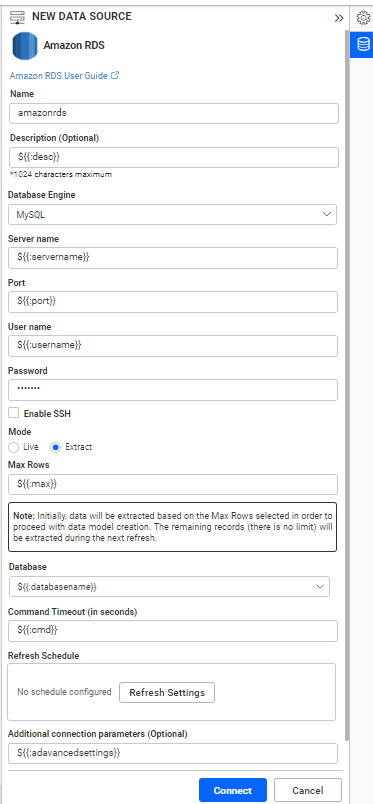
Dashboard Parameter

Note: Refer to the Dashboard Parameter Documentation and Custom Attributes Documentation for more details.
Amazon RDS supported database engine in Bold bi
- MySQL
- MariaDB
- Amazon Aurora MySQL
- SQL server
- PostgreSQL
- Amazon Aurora PostgreSQL
- Oracle
Database Engine

There are two connection types available in a data source:
* Live mode
* Extract modeLive mode connection
In this connection type, a data source is directly fetched from the source. Choose the Live mode option for this connection.
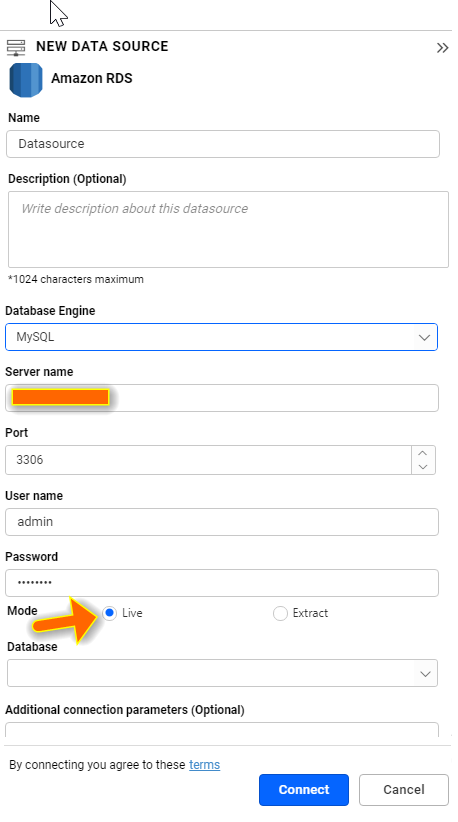
Data Preview
- Click Connect to connect to the Amazon RDS server with configured details.
The schema represents the collection list retrieved from the Amazon RDS server. This dialog displays a list of schemas in treeview and their corresponding values.
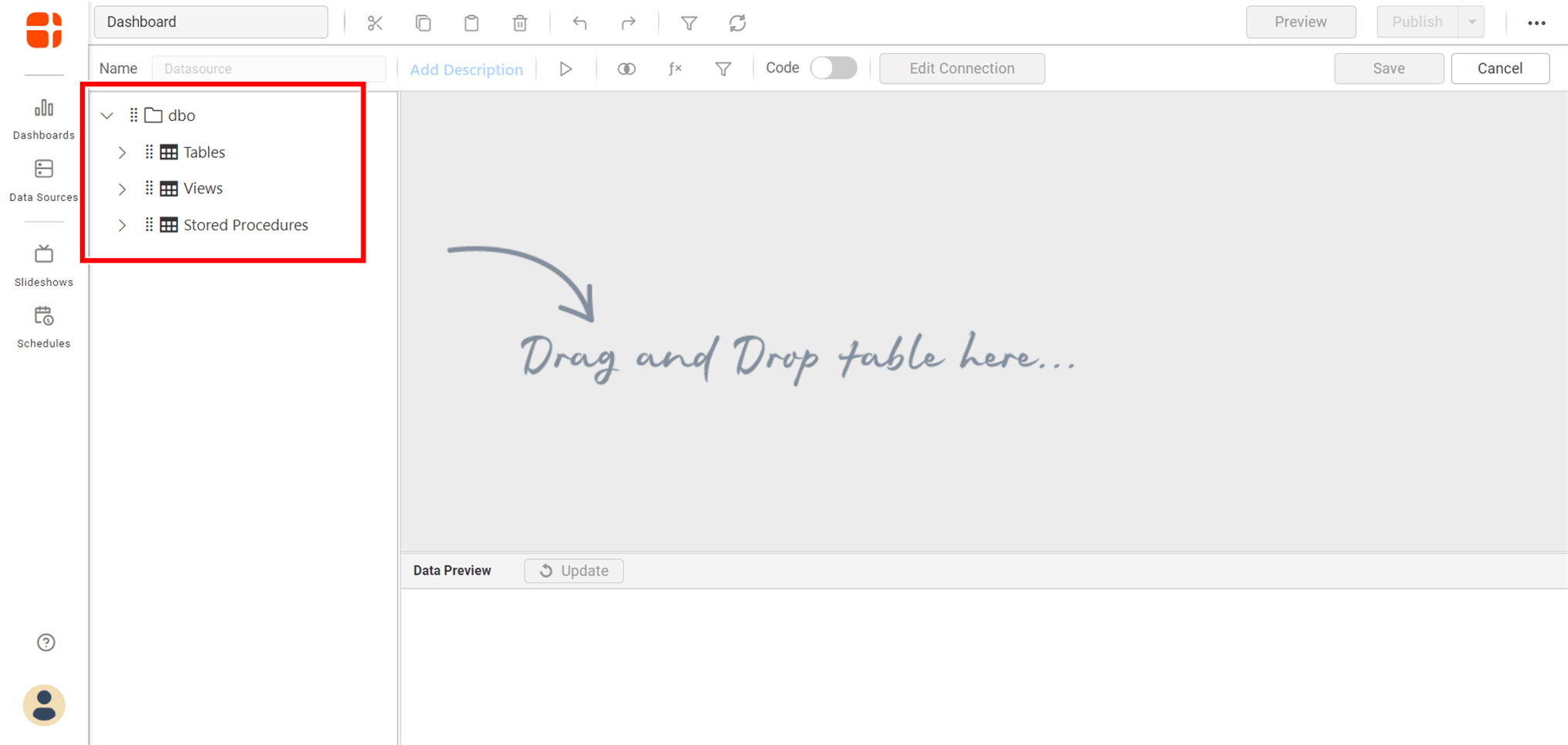
-
Now, the data design view page with the selected table schema opens. Drag and drop the table.
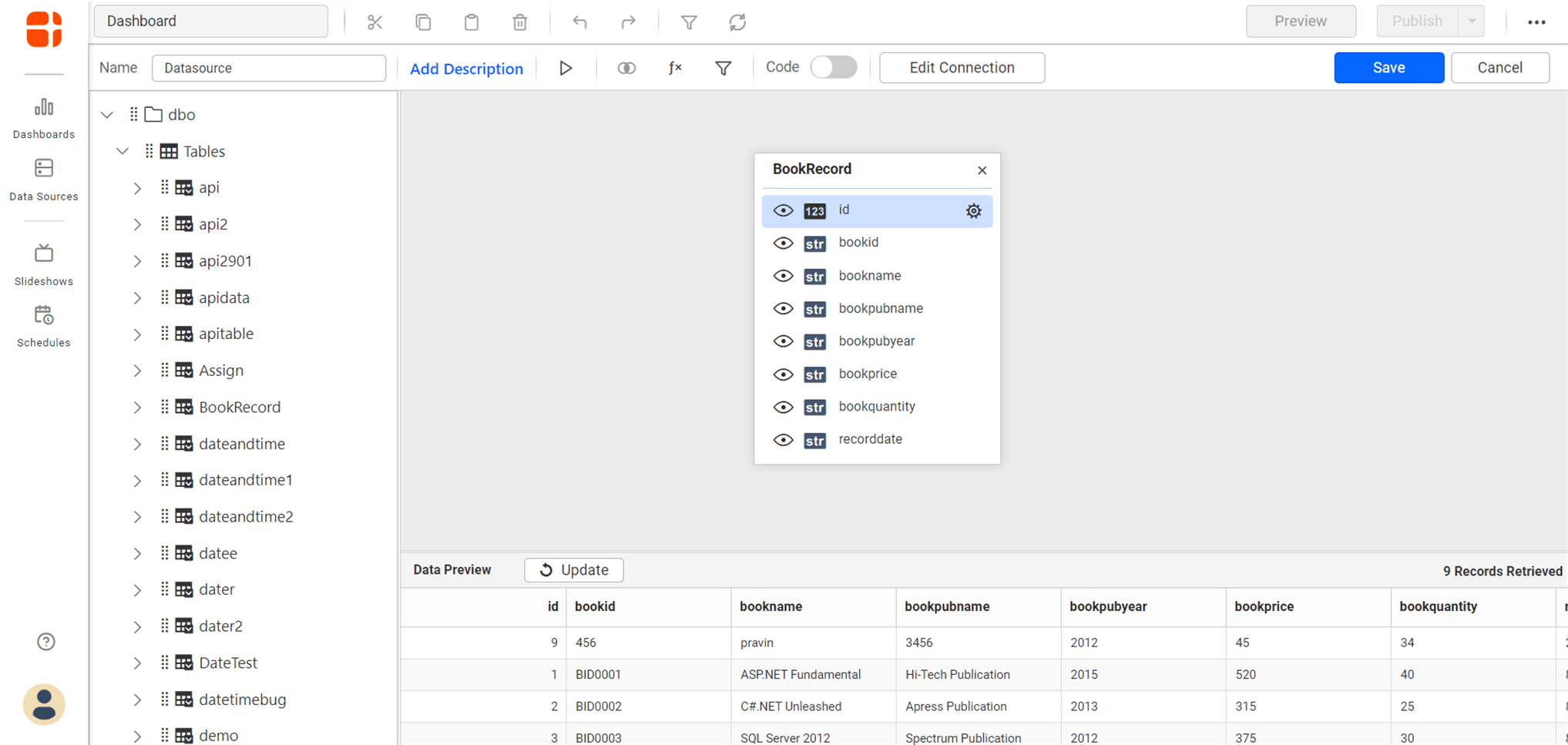
You can use the Code View options for passing queries to display data.
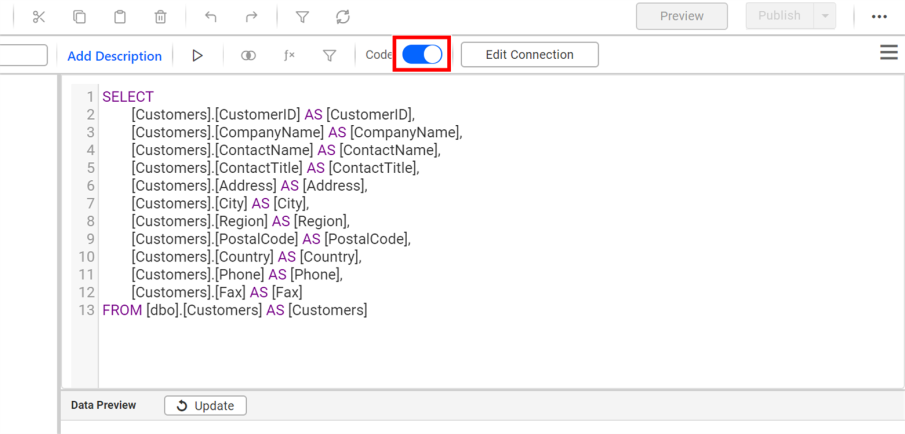
-
Click Save to save the data source with a relevant name.
Extract mode connection
In this connection type, a data source is fetched from the source periodically. Choose the Extract mode option for this connection.

Refresh Settings
Steps to configure the data source refresh settings:
-
Click on Refresh Settings in the configuration panel.
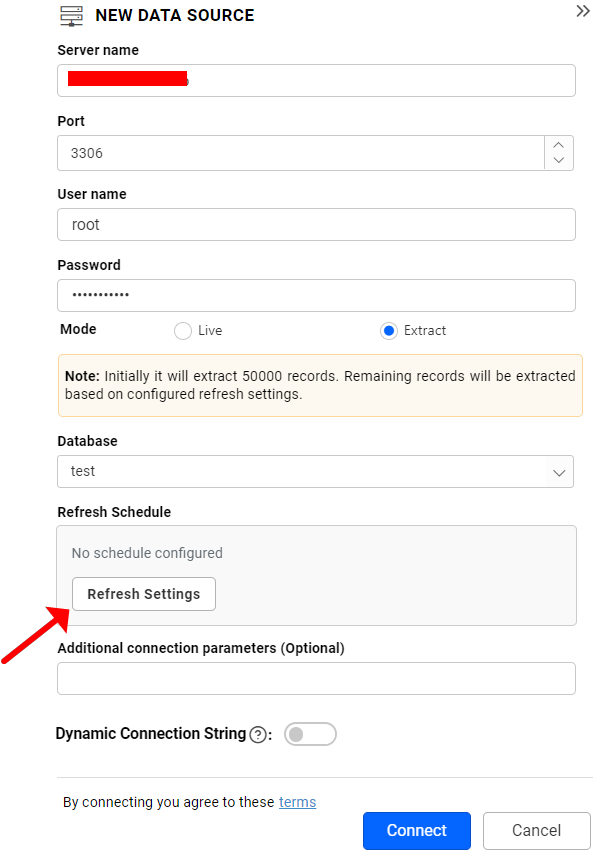
-
Select the recurrence type, recurrence start and end dates in the Refresh Setting dialog box.
- Data refresh can be scheduled hourly, daily, weekly, and monthly.
- The Application Time Zone is displayed below the date picker. The start time of the schedule is converted to the client Time Zone and shown on the right side for users’ convenience. After selecting, click Schedule.

Preview and data import
- Click Connect to connect to the Amazon RDS server with configured details.
- The Extract Data dialog opens. This dialog has two modes of connection either via Table or Custom query. Under custom query option, write the required query and click Connect.
Under Table option, the dialog displays list of tables and views in treeview. Select the required table(s) or view(s) from treeview to use in the designer. The option is available for configuring incremental refresh column (The table must have a primary key column and date column to configure this option) for the selected items in the right side panel. If you configured it, then the data source will work on Incremental update, otherwise works on Full load concept. And finally click Connect.
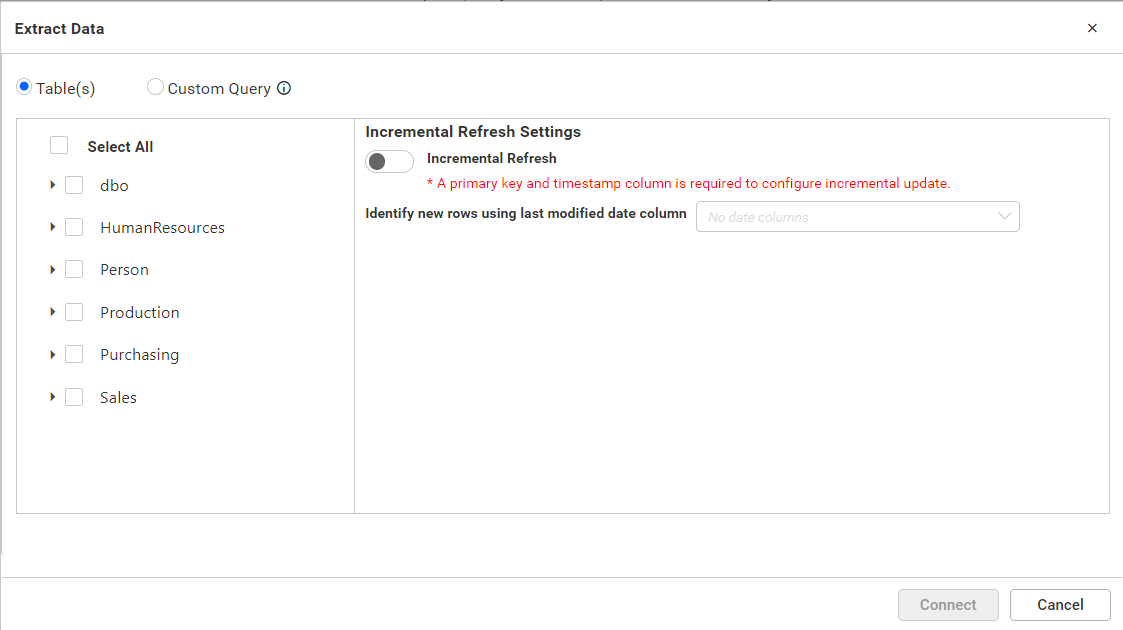
-
Now, the data design view page with the selected table schema opens. Drag and drop the table.
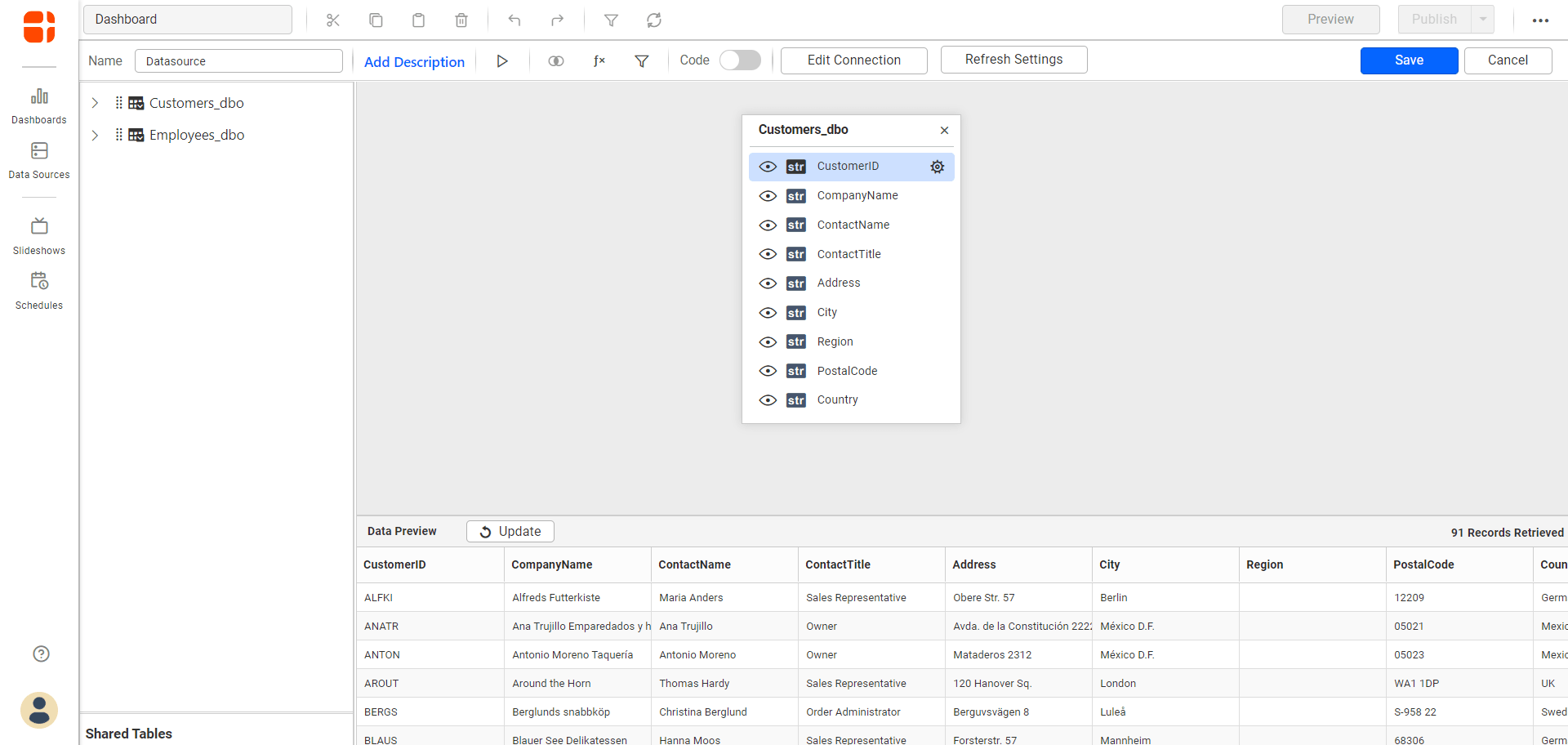
You can use the Code View options for passing a query to display data.
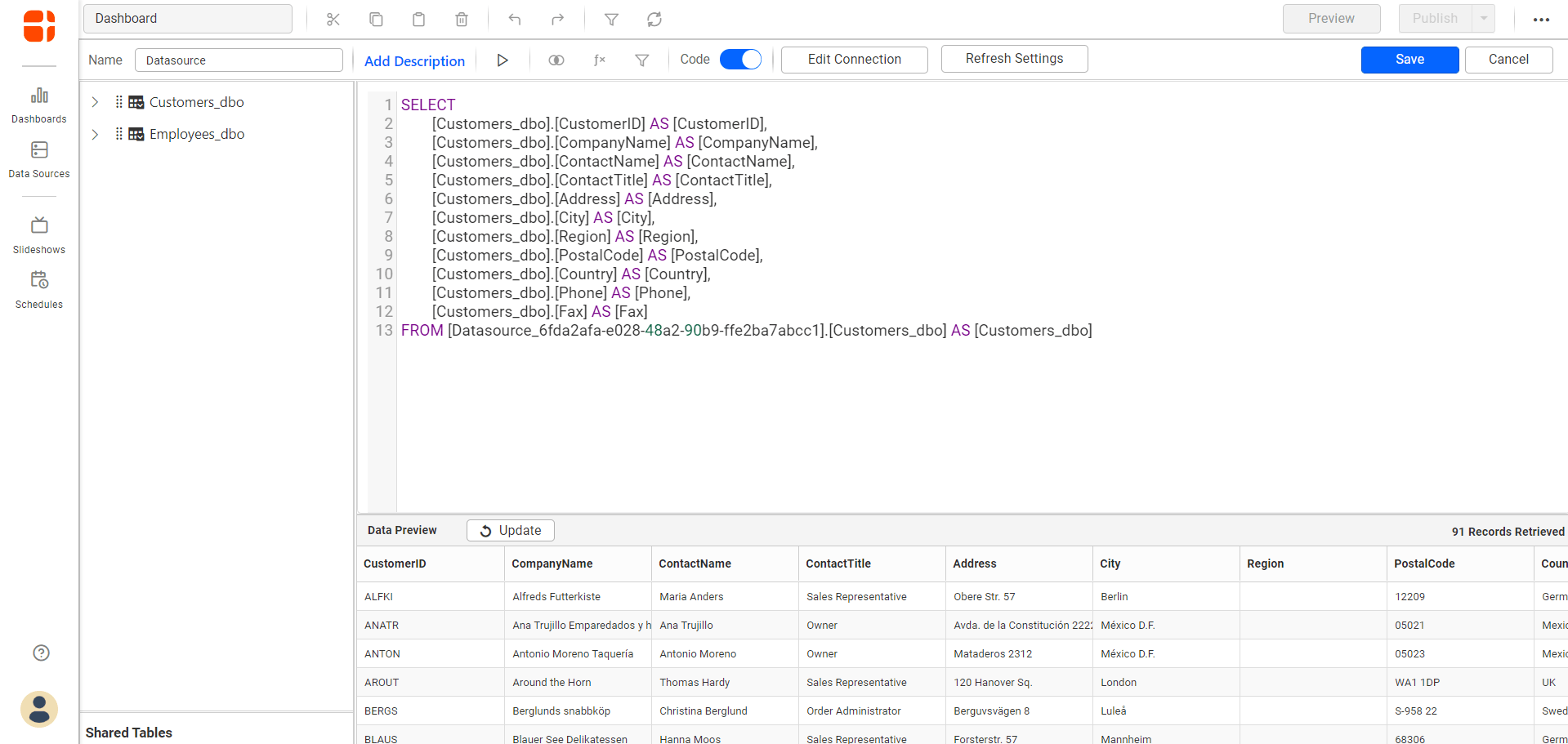
-
Click Save to save the data source with a relevant name.
NOTE: In the future, you can edit the connection information for both Live and Extract mode connections using the Edit Connection option.
Connect using custom attribute and dashboard parameter
We have added support for custom attributes and dashboard parameters to the data source connection. You can connect to the data source using custom attributes or dashboard parameters.
Custom Attribute

Dashboard Parameter

Note: Refer to the Dashboard Parameter Documentation and Custom Attributes Documentation for more details.
Connecting Bold BI to Amazon RDS Data Source via REST API
Prerequisites
Type while creating the data source needs to be one of the following:
* amazonrdsmysql
* amazonrdsmariadb
* amazonrdsamazonauroramysql
* amazonrdsamazonaurorapostgresql
* amazonrdspostgresql
* amazonrdssqlserver
* amazonrdsoracleModes
Only the live mode data source can be created and edited through the REST API.
Parameters for creating Data Source
NOTE: Join support can only be provided during the creation of a new data source. Join in edit connection mode is not supported.
| Parameters | Details |
|---|---|
| Servername required | string
Server name or Host name of the connection |
| Port required | string
Port number used to connect to amazon rds
|
| InstanceName optional | string
InstanceName or service name of the connection. Required for the oracle database engine.
|
| Username required | string
A valid user name for the connection |
| Password required | string
A valid Password for the connection |
| Database required | string
database which needs to be connected |
| Schemaname required for table mode | string
Enter a valid Schemaname |
| Tablename required for table mode | string
Enter a valid Tablename |
JoinType Required For Join Info | string
Enter a valid JoinType For Example (Inner,Outer) |
| LeftTable Required For Join Info | string
Enter a valid Left Table name |
| RightTable Required For Join Info | string
Enter a valid Right Table name |
| LeftField Required For Join Info | string
Enter a valid Left Table Column Name |
| RightField Required For Join Info | string
Enter a valid Right Table Column Name |
| Condition Required For Join Info | string
Enter a valid Condition For Example (AND,OR) |
| LeftField Required For Join Info | string
Enter a valid Left Table Column Name |
| Operator Required For Join Info | string
Enter a Valid Operator For Example (=,>=) |
| Value Optional For only Join Info | string
Specifically choose the column values. |
| Query required for code view mode | string
Enter a valid Query |
| AdvancedSettings optional | string
Additional optional connection parameters can be provided. By default, it is empty. |
| CommandTimeout optional | string
Enter a valid Timeout for the connection. By default, it is 300 |
| IsEnableSSL optional | string
Enable or disable SSL. Applicable only for the sqlserver database engine.
|
| IsSshConnection optional | `boolean` Enable or disable SSH. By default, it is false. |
| SshServerName optional | string
Enter a valid Ssh Server name. By default, it is empty. |
| SshPort optional | `integer` Enter a valid Ssh Port number. |
| SshUserName optional | string
Enter a valid Ssh Username. By default, it is empty. |
| SshPassword optional | string
Enter a valid Ssh Password. By default, it is empty. |
| Expressions optional | `Array of Objects` |
Parameters for edit the connection while upload the dashboard via API
| Parameters | Details |
|---|---|
| ServerName required | string
Server name or Host name of the connection |
| Port required | string
Port number used to connect to amazon rds
|
| InstanceName optional | string
InstanceName or service name of the connection. Required for the oracle database engine.
|
| UserName required | string
A valid user name for the connection |
| Password required | string
A valid Password for the connection |
| Database required | string
database which needs to be connected |
| Schema required for table mode | string
Enter a valid Schemaname |
| AdvancedSettings optional | string
Additional optional connection parameters can be provided. By default, it is empty. |
| CommandTimeout optional | string
Enter a valid Timeout for the connection. By default, it is 300 |
| IsEnableSSL optional | string
Enable or disable SSL. Applicable only for the sqlserver database engine.
|
| TrustServerCertificate optional | `boolean` To enable trusting the server's certificate without validation, set it to true. To perform standard SSL certificate validation, set it to false. By default, it is false. |
| IsSshConnection optional | `boolean` Enable or disable SSH. By default, it is false. |
| SshServerName optional | string
Enter a valid Ssh Server name. By default, it is empty. |
| SshPort optional | `integer` Enter a valid Ssh Port number. |
| SshUserName optional | string
Enter a valid Ssh Username. By default, it is empty. |
| SshPassword optional | string
Enter a valid Ssh Password. By default, it is empty. |
Parameters for adding expressions when creating Data Source
| Parameters | Details |
|---|---|
| Name required | string
Name of the Expression
|
| Expression required | string
Expression
|
Parameters for editing Data Source
NOTE: When editing a Data Source via API, all parameters are optional. Only the parameter that needs to be changed should be provided.
Parameters for modifying expressions when editing Data Source
| Parameters | Details |
|---|---|
| Name required | string
Name of the Expression
|
| Expression required | string
Expression
|
| Action optional | string
add/delete/edit
By default, it is add.
|
| NewName optional | string
For renaming the expression. This is applicable only if the Action is edit
|
Connection Sample for Table Mode
For creating connection:
"Connection":
{
"Servername": "string",
"Port": "string",
"InstanceName": "string",
"Username": "string",
"Password": "string",
"Database": "string",
"Schemaname": "string",
"Tablename": "string",
"AdvancedSettings": "string",
"CommandTimeout": "string",
"IsEnableSSL": "string",
"IsSshConnection": "false",
"SshServerName": "string",
"SshPort": 0,
"SshUsername": "string",
"SshPassword": "string",
"Expressions" : [{
"Name": "Expression1",
"Expression" : "SUM(numeric expression)"
},
{
"Name": "Expression2",
"Expression" : "UPPER(string expression)"
}]
}
For creating connection with multiple tables :
"Connection":
{
"Servername": "string",
"Port": "string",
"InstanceName": "string",
"Username": "string",
"Password": "string",
"Database": "string",
"Tables": [
{
"Tablename": "string",
"Schemaname": "string"
},
{
"Tablename": "string",
"Schemaname": "string"
}
],
"JoinInfo": [
{
"JoinType": "string",
"LeftTable": "string",
"RightTable": "string",
"JoinFieldInfos": [
{
"Condition": "string",
"LeftField": "string",
"Operator": "string",
"RightField": "string",
"Value": "string"
},
{
"Condition": "string",
"LeftField": "string",
"Operator": "string",
"RightField": "string",
"Value": "string"
}
]
}
],
"AdvancedSettings": "string",
"CommandTimeout": "string",
"IsEnableSSL": "string",
"IsSshConnection": "false",
"SshServerName": "string",
"SshPort": 0,
"SshUsername": "string",
"SshPassword": "string",
"Expressions" : [{
"Name": "Expression1",
"Expression" : "SUM(numeric expression)"
},
{
"Name": "Expression2",
"Expression" : "UPPER(string expression)"
}]
}
For editing connection:
"Connection":
{
"Servername": "string",
"Port": "string",
"InstanceName": "string",
"Username": "string",
"Password": "string",
"Database": "string",
"Schemaname": "string",
"Tablename": "string",
"AdvancedSettings": "string",
"CommandTimeout": "string",
"IsEnableSSL": "string",
"IsSshConnection": "false",
"SshServerName": "string",
"SshPort": 0,
"SshUsername": "string",
"SshPassword": "string",
"Expressions" : [{
"Name": "Expression1",
"Expression" : "SUM(numeric expression)",
"NewName" : "Sum",
"Action": "edit"
},
{
"Name": "Expression2",
"Expression" : "UPPER(string expression)"
"Action": "delete"
}]
}
NOTE: Through the REST API, the data source can be created or edited with only one table. If a different table is provided in editing the data source, the table will be replaced. The widgets will be retained only if the schema is the same as the previous table.
Connection Sample for Code View Mode
"Connection":
{
"Servername": "string",
"Port": "string",
"InstanceName": "string",
"Username": "string",
"Password": "string",
"Database": "string",
"Query": "string",
"AdvancedSettings": "string",
"CommandTimeout": "string",
"IsEnableSSL": "string",
"IsSshConnection": "false",
"SshServerName": "string",
"SshPort": 0,
"SshUsername": "string",
"SshPassword": "string",
"Expressions" : [{
"Name": "Expression1",
"Expression" : "SUM(numeric expression)"
},
{
"Name": "Expression2",
"Expression" : "UPPER(string expression)"
}]
}
Sample connection for editing the connection while uploading the dashboard via API.
"Connection": {
"ServerName": "",
"Database": "",
"UserName": "",
"Password": "",
"Port": "",
"SslMode": "",
"TrustServerCertificate": "",
"AdvancedSettings": "",
"CommandTimeout": "" ,
"Schema": ""
} Related links
- Choose Amazon RDS data source
- Connect to Amazon RDS
- Live mode connection
- Extract mode connection
- Connecting Bold BI to Amazon RDS Data Source via REST API
- Related links
Having trouble getting help?
Contact Support- Choose Amazon RDS data source
- Connect to Amazon RDS
- Live mode connection
- Extract mode connection
- Connecting Bold BI to Amazon RDS Data Source via REST API
- Related links
Having trouble getting help?
Contact Support